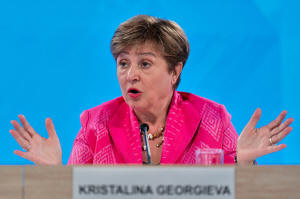IMF chief warns of economic uncertainty and offers this advice: 'Buckle
up'
[October 09, 2025] By
FATIMA HUSSEIN
WASHINGTON (AP) — The global economy is holding up better than expected
despite major shocks such as President Donald Trump's tariffs, but the
head of the International Monetary Fund says that resilience may not
last.
“Buckle up,” Managing Director Kristalina Georgieva said in a speech at
a think tank Wednesday. “Uncertainty is the new normal and it is here to
stay.”
Her comments at the Milken Institute come on a day when gold prices hit
$4,000 an ounce for the first time as investors seek safe haven from a
weaker dollar and geopolitical uncertainty and before the IMF and World
Bank hold their annual meetings next week in Washington. Trump's trade
penalties are expected to be in sharp focus when global finance leaders
and central bankers gather.
The worldwide economy is forecast to grow by 3% this year, and Georgieva
is citing a number of factors for why it may not slip below that:
Countries have put in place decisive economic policies, the private
sector has adapted and the tariffs have proved less severe than
originally feared.
“But before anyone heaves a big sigh of relief, please hear this: Global
resilience has not yet been fully tested. And there are worrying signs
the test may come. Just look at the surging global demand for gold,” she
said.
On Trump's tariffs, she says “the full effect is still to unfold. In the
U.S., margin compression could give way to more price pass-through,
raising inflation with implications for monetary policy and growth."

The Republican administration imposed import taxes on nearly all U.S.
trading partners in April, including Canada, Mexico, Brazil, China and
even the tiny African nation of Lesotho. “We’re the king of being
screwed by tariffs,” Trump said Tuesday in the Oval Office during a
meeting with Canadian Prime Minister Mark Carney.
While the U.S. has announced some trade frameworks with nations such as
the United Kingdom and Vietnam, the tariffs have created uncertainty
worldwide.
[to top of second column] |

International Monetary Fund (IMF) Managing Director Kristalina
Georgieva speaks during a news conference at the International
Monetary Fund (IMF) headquarters in Washington, April 25, 2025. (AP
Photo/Jose Luis Magana, File)
 “Elsewhere, a flood of goods
previously destined for the U.S. market could trigger a second round
of tariff hikes,” Georgieva said.
The Supreme Court next month will hear arguments about whether Trump
has the authority to impose some of his tariffs under the
International Emergency Economic Powers Act.
In her wide-ranging remarks, Georgieva pointed to youth discontent
around the world as many young people foresee a future where they
earn less than their parents.
“The young are taking their disappointment to the streets from Lima
to Rabat, from Paris to Nairobi, from Kathmandu to Jakarta, all are
demanding better opportunities," she said. "And here in the U.S.,
the chances of growing up to earn more than your parents keeps
falling and here too, discontent has been evident — and it has
helped precipitate the policy revolution that is now unfolding,
reshaping trade, immigration and many international frameworks.”
She also called for greater internal trade in Asia, more business
friendly changes in Africa and more competitiveness in Europe.
For the United States, Georgieva urged the government to address the
federal debt and to encourage household saving.
The national debt is the total amount of money that the federal
government owes to its creditors. The federal debt has increased
from $380 billion in 1925 to $37.64 trillion in 2025, according to
Treasury Department data.
The Congressional Budget Office reported in July that Trump’s new
tax and spending law will add $3.4 trillion to that total through
2034.
The IMF is a 191-country lending organization that seeks to promote
global growth and financial stability and to reduce poverty.
All contents © copyright 2025 Associated Press. All rights reserved |